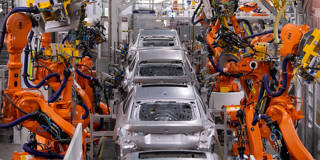Labor productivity growth in the US has been more than double that of the eurozone for the past 20 years. A forthcoming report from Mario Draghi will recommend removing barriers to competition, which would intensify the pressure on firms to innovate, but Europe desperately needs newer ideas than this if it is to see its productivity rise.
HONG KONG – The gap between productivity growth in the United States and Europe paints a stark and, for Europeans, depressing picture. In the two decades since 2004, US productivity growth, as measured by the value of output per hour worked, has been more than double that of the eurozone. Whereas eurozone productivity has flat-lined and even fallen slightly since the outbreak of the COVID-19 pandemic, US non-farm output per hour has risen by more than 6% over the same period – more than adequate performance by America’s own historical standards.
Something seems to be going seriously right in the US and seriously wrong in Europe. Some accounts point to the strong fiscal stimulus applied in the US since the outbreak of the pandemic. For Europeans this explanation is reassuring, because it suggests that the differential is transitory. After all, the US can’t run massive budget deficits and live beyond its means indefinitely.
But while strong spending stimulus can trigger rapid output and employment growth, it is not clear why it should produce faster productivity growth. On the contrary, given strong employment growth and tight labor markets, one might expect US companies to be forced to take on less productive workers, with negative implications for output per hour. More likely, tight labor markets in the US may mean that firms, unable to find an adequate supply of workers at any price, are impelled to substitute capital for labor – to invest in labor-saving technology.

HONG KONG – The gap between productivity growth in the United States and Europe paints a stark and, for Europeans, depressing picture. In the two decades since 2004, US productivity growth, as measured by the value of output per hour worked, has been more than double that of the eurozone. Whereas eurozone productivity has flat-lined and even fallen slightly since the outbreak of the COVID-19 pandemic, US non-farm output per hour has risen by more than 6% over the same period – more than adequate performance by America’s own historical standards.
Something seems to be going seriously right in the US and seriously wrong in Europe. Some accounts point to the strong fiscal stimulus applied in the US since the outbreak of the pandemic. For Europeans this explanation is reassuring, because it suggests that the differential is transitory. After all, the US can’t run massive budget deficits and live beyond its means indefinitely.
But while strong spending stimulus can trigger rapid output and employment growth, it is not clear why it should produce faster productivity growth. On the contrary, given strong employment growth and tight labor markets, one might expect US companies to be forced to take on less productive workers, with negative implications for output per hour. More likely, tight labor markets in the US may mean that firms, unable to find an adequate supply of workers at any price, are impelled to substitute capital for labor – to invest in labor-saving technology.